The Multivariable Alexander Polynomial: Difference between revisions
No edit summary |
No edit summary |
||
| Line 4: | Line 4: | ||
<!--$$?MultivariableAlexander$$--> |
<!--$$?MultivariableAlexander$$--> |
||
<!--Robot Land, no human edits to "END"--> |
|||
{{HelpAndAbout| |
|||
n = 2 | |
|||
n1 = 3 | |
|||
in = <nowiki>MultivariableAlexander</nowiki> | |
|||
out= <nowiki>MultivariableAlexander[L][t] returns the multivariable Alexander polynomial of a link L as a function of the variable t[1], t[2], ..., t[c], where c is the number of components of L.</nowiki> | |
|||
about= <nowiki>The multivariable Alexander program was written by Dan Carney at the University of Toronto in the summer of 2005.</nowiki>}} |
|||
<!--END--> |
<!--END--> |
||
{{Knot Image|L8a21|gif}} |
|||
| ⚫ | |||
The link [[L8a21]] is symmetric under cyclic permutations of its components but not under interchanging two adjacent components. It is amusing to see how this is reflected in its multivariable Alexander polynomial: |
|||
<!--$$mva = MultivariableAlexander[Link[8, Alternating, 21]][t] /. { |
|||
t[1] -> t1, t[2] -> t2, t[3] -> t4, t[4] -> t3 |
|||
}$$--> |
|||
<!--Robot Land, no human edits to "END"--> |
|||
{{InOut| |
|||
n = 4 | |
|||
in = <nowiki>mva = MultivariableAlexander[Link[8, Alternating, 21]][t] /. { |
|||
t[1] -> t1, t[2] -> t2, t[3] -> t4, t[4] -> t3 |
|||
}</nowiki> | |
|||
out= <nowiki>-t1 - t2 + t1 t2 - t3 + 2 t1 t3 + t2 t3 - t1 t2 t3 - t4 + t1 t4 + |
|||
2 t2 t4 - t1 t2 t4 + t3 t4 - t1 t3 t4 - t2 t3 t4</nowiki>}} |
|||
<!--END--> |
|||
<!--$$mva - (mva /. {t1->t2, t2->t3, t3->t4, t4->t1})$$--> |
|||
<!--Robot Land, no human edits to "END"--> |
|||
{{InOut| |
|||
n = 5 | |
|||
in = <nowiki>mva - (mva /. {t1->t2, t2->t3, t3->t4, t4->t1})</nowiki> | |
|||
out= <nowiki>0</nowiki>}} |
|||
<!--END--> |
|||
<!--$$mva - (mva /. {t1->t2, t2->t1})$$--> |
|||
<!--Robot Land, no human edits to "END"--> |
|||
{{InOut| |
|||
n = 6 | |
|||
in = <nowiki>mva - (mva /. {t1->t2, t2->t1})</nowiki> | |
|||
out= <nowiki>t1 t3 - t2 t3 - t1 t4 + t2 t4</nowiki>}} |
|||
<!--END--> |
|||
But notice the funny labelling of the components! At the moment there is no way to tell <code>MultivariableAlexander</code> which variable is to be associated with what variable so <code>MultivariableAlexander</code> chooses an arbitrary ordering of tha variables. Hence we had to rename <code>t[3]</code> to be <code>t4</code> and <code>t[4]</code> to be <code>t3</code>. |
|||
(To be precise, <code>MultivariableAlexander</code> orders the components so that its output would be lexicographically minimal among all possible orderings. This way it is at least guaranteed that different presentations for the same link will yield the same output for <code>MultivariableAlexander</code>.) |
|||
| ⚫ | |||
<!--$$Select[AllLinks[], (MultivariableAlexander[#][t] == 0) &]$$--> |
<!--$$Select[AllLinks[], (MultivariableAlexander[#][t] == 0) &]$$--> |
||
<!--Robot Land, no human edits to "END"--> |
|||
{{InOut| |
|||
n = 7 | |
|||
in = <nowiki>Select[AllLinks[], (MultivariableAlexander[#][t] == 0) &]</nowiki> | |
|||
out= <nowiki>{Link[9, NonAlternating, 27], Link[10, NonAlternating, 32], |
|||
Link[10, NonAlternating, 36], Link[10, NonAlternating, 107], |
|||
Link[11, NonAlternating, 244], Link[11, NonAlternating, 247], |
|||
Link[11, NonAlternating, 334], Link[11, NonAlternating, 381], |
|||
Link[11, NonAlternating, 396], Link[11, NonAlternating, 404], |
|||
Link[11, NonAlternating, 406]}</nowiki>}} |
|||
<!--END--> |
<!--END--> |
||
{{Knot Image Quadruple|L9n27|gif|L10n32|gif|L10n36|gif|L10n107|gif}} |
|||
{{Knot Image Quadruple|L11n244|gif|L11n247|gif|L11n334|gif|L11n381|gif}} |
|||
{{Knot Image Triple|L11n396|gif|L11n404|gif|L11n406|gif}} |
|||
[[User:Drorbn|Dror]] doesn't understand the multivariable Alexander polynomial well enough to give simple topological reasons for the vanishing of the said polynomial for these knots. |
|||
Revision as of 17:16, 25 September 2005
(For In[1] see Setup)
|
| ||||||||
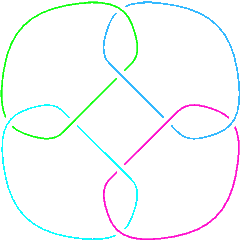 L8a21 |
The link L8a21 is symmetric under cyclic permutations of its components but not under interchanging two adjacent components. It is amusing to see how this is reflected in its multivariable Alexander polynomial:
In[4]:=
|
mva = MultivariableAlexander[Link[8, Alternating, 21]][t] /. {
t[1] -> t1, t[2] -> t2, t[3] -> t4, t[4] -> t3
}
|
Out[4]=
|
-t1 - t2 + t1 t2 - t3 + 2 t1 t3 + t2 t3 - t1 t2 t3 - t4 + t1 t4 +
2 t2 t4 - t1 t2 t4 + t3 t4 - t1 t3 t4 - t2 t3 t4
|
In[5]:=
|
mva - (mva /. {t1->t2, t2->t3, t3->t4, t4->t1})
|
Out[5]=
|
0
|
In[6]:=
|
mva - (mva /. {t1->t2, t2->t1})
|
Out[6]=
|
t1 t3 - t2 t3 - t1 t4 + t2 t4
|
But notice the funny labelling of the components! At the moment there is no way to tell MultivariableAlexander which variable is to be associated with what variable so MultivariableAlexander chooses an arbitrary ordering of tha variables. Hence we had to rename t[3] to be t4 and t[4] to be t3.
(To be precise, MultivariableAlexander orders the components so that its output would be lexicographically minimal among all possible orderings. This way it is at least guaranteed that different presentations for the same link will yield the same output for MultivariableAlexander.)
There are 11 links with up to 11 crossings whose multivariable Alexander polynomial is . Here they are:
In[7]:=
|
Select[AllLinks[], (MultivariableAlexander[#][t] == 0) &]
|
Out[7]=
|
{Link[9, NonAlternating, 27], Link[10, NonAlternating, 32],
Link[10, NonAlternating, 36], Link[10, NonAlternating, 107],
Link[11, NonAlternating, 244], Link[11, NonAlternating, 247],
Link[11, NonAlternating, 334], Link[11, NonAlternating, 381],
Link[11, NonAlternating, 396], Link[11, NonAlternating, 404],
Link[11, NonAlternating, 406]}
|
 L9n27 |
 L10n32 |
 L10n36 |
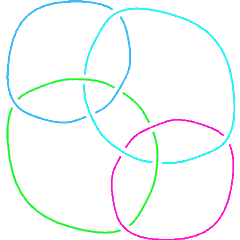 L10n107 |
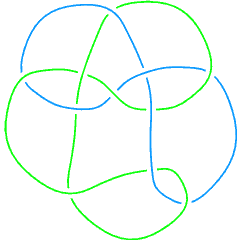 L11n244 |
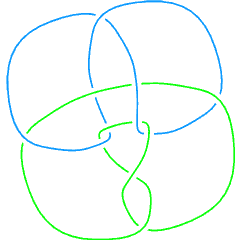 L11n247 |
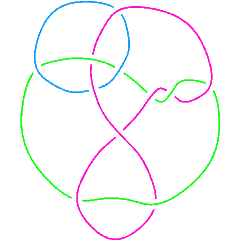 L11n334 |
 L11n381 |
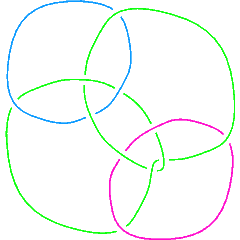 L11n396 |
 L11n404 |
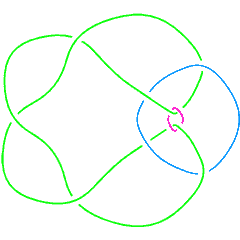 L11n406 |
Dror doesn't understand the multivariable Alexander polynomial well enough to give simple topological reasons for the vanishing of the said polynomial for these knots.
